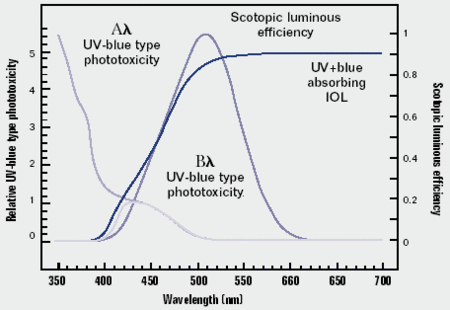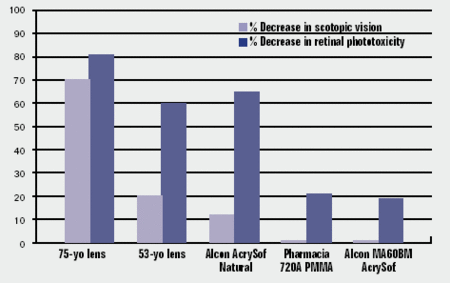More evidence needed to evaluate claims for blue-light-filtering IOLs, researchers say
An article in the British Journal of Ophthalmology notes unknowns that the authors say must be addressed in future studies.
Two key pieces of information are still needed before surgeons can make informed decisions about the performance of blue-light-filtering IOLs, according to the authors of a recent article in the British Journal of Ophthalmology.
Specifically, researchers still have incomplete knowledge of the role blue-light phototoxicity plays in retinal aging, as well as how much blue light can be filtered before visual performance in scotopic conditions is compromised, according to authors Martin A. Mainster, PhD, MD, and Janet R. Sparrow, PhD.
The current understanding of the lens relies on an assessment of hypothetical risks and benefits, the authors said in the article, but the clinical implications of these hypothetical analyses have not yet been determined.
The AcrySof Natural IOL is the only blue-light-filtering IOL approved for use in the United States. According to Alcon, the AcrySof Natural approximates the light-transmission properties of a healthy human adult crystalline lens.
The lens has been somewhat controversial since its introduction, with proponents saying it provides protection that is lacking in standard IOLs and critics claiming that its blue-light filtering may interfere with vision in scotopic situations.
Some of these concerns are explored in the BJO article, but the article itself has been met with controversy, and even the article’s two authors draw differing conclusions from their research.
Dr. Sparrow says in the article that she would opt to have a blue-light-filtering IOL implanted in her own eye if the need arises, while Dr. Mainster says he would choose to have an ultraviolet-filtering IOL implanted and wear sunglasses in bright-light situations.
As this issue is being prepared for press, John Marshall, PhD, is scheduled to dispute some of the article’s claims in a presentation at the American Society of Cataract and Refractive Surgery meeting.
Despite the controversy, Alcon noted in its first quarter 2004 financial statement that the AcrySof Natural “continued to gain physician acceptance,” although no sales figures for the lens were included in the statement.
Missing information
Dr. Mainster, who in 1978 published data showing that clear PMMA IOLs transmitted potentially harmful UV radiation, said in an interview that one of the points of the BJO article is that there is a difference between filtering out blue light, which is important for night vision, and UV radiation, which is not useful for vision.
“In 1986, I recommended blocking violet light between 400 and 430 nm in addition to UV in order to increase retinal protection without significantly decreasing scotopic or photopic vision. My problem with the AcrySof Natural lens is that a 20 D IOL blocks 50% of blue light at 445 nm and 25% at 480 nm,” Dr. Mainster told Ocular Surgery News. “By restricting blue light in addition to UV and violet, the AcrySof Natural limits scotopic vision, which decreases with aging in everyone over 50.
“With UV-only blocking IOLs, people should wear sunglasses in bright environments that can be removed for optimal vision in dim ones,” he said. “I believe that AcrySof Natural IOL users should also wear sunglasses in bright environments because they have limited protection against Ham’s UV-blue type retinal phototoxicity and negligible protection against Noell’s blue-green type phototoxicity. But the AcrySof Natural’s blue-absorbing chromophores are always there when users remove their sunglasses.”
Dr. Mainster said that he disagrees with advocates of the AcrySof Natural lens who argue that scotopic vision is not important. “Ninety-five percent of the retina’s photoreceptors are rods because we need to see at night,” he said. “It’s important that older adults avoid tripping over shoes or pets while walking to the bathroom in the dark.”
The BJO article also addresses the issue of what is known about blue-light exposure as a cause of retinal damage.
“For many years, it’s been thought that light exposure contributes to macular degeneration, but epidemiological studies that have attempted to demonstrate this have really been inconclusive,” Dr. Sparrow said in an interview.
She and Dr. Mainster suggest in the BJO article that phototoxicity might be additive, so that each exposure to blue light is more damaging than the last. In addition, there may be contributing factors, such as genetics and environment, that affect individual susceptibility to blue light.
Studies could be undertaken to answer these questions, Dr. Mainster noted, but they would be difficult to design in a retrospective fashion or would take years or decades to complete in a prospective fashion.
“It’s extremely difficult to design such a study because of the difficulty of figuring out retrospectively what someone’s cumulative light exposure was,” Dr. Mainster said. “On the other hand, it would be possible to design a prospective study, but it would have to take place over a long period of time.”
In an interview, Dr. Marshall agreed that such studies would take years, but he added that no such studies have been undertaken for UV-blocking IOLs either.
| Table 1 |
| UV-blue type phototoxicity, scotopic sensitivity (and blue-green phototoxicity) and the Alcon Natural IOL’s transmittance spectrum. Aë and Bë are the action spectra of UV-blue type of phototoxicity in aphakic and phakic eyes, respectively. Blue-green retinal phototoxicity has an action spectrum similar to rhodopsin and scotopic sensitivity, so protection against it causes a comparable percentage decrease in scotopic sensitivity. It is unknown whether either, neither or both types of experimental acute retinal phototoxicities play a significant role in AMD, according to Dr. Mainster.  |
| Table 2 |
| Scotopic sensitivity decreases as protection against acute UV-blue retinal phototoxicity increases. UV+blue filtering IOLs have better protection against acute phototoxicity but worse scotopic performance than UV-only blocking IOLs.  Source: Mainster MA |
Action spectrum
Researchers must also determine the “action spectrum” of blue light as it relates to aging, Dr. Mainster noted.
There are at least two types of retinal phototoxicities, a UV-blue type that increases with decreasing wavelength and a blue-green type that has an action spectrum similar to scotopic sensitivity, Dr. Mainster said. Blue-green phototoxicity occurs at lower retinal irradiances but requires exposures of greater duration, the authors said in the BJO article. Either or both of these phototoxicities may be involved in age-related diseases, but their effects on retinal aging have yet to be determined, they added.
“Laboratory studies involve intense light exposures ranging from a few minutes to many hours in duration. It’s very important to differentiate between acute phototoxicity in a laboratory environment and lifelong human light exposure,” said Dr. Mainster.
No consensus
The two authors disagreed on whether they would want to be implanted with a blue-light-filtering IOL. In the article, the authors said that, “if and when we need one,” Dr. Sparrow would choose a blue-light-filtering IOL, but of the currently available IOLs, Dr. Mainster would opt for a UV-only blocking lens.
“There are many questions that haven’t been answered,” Dr. Sparrow said. “However, in the meantime, there is a very good biological basis for being concerned about the potential damaging effects of blue light in the elderly. Now we know the aging compounds that mediate that blue-light damage, and we know that the natural crystalline lens attenuates some of that blue light.”
Dr. Mainster expressed concern about the performance of the AcrySof Natural lens in scotopic conditions. He said he would choose to have an IOL that provides UV protection and wear sunglasses in bright environments that could be removed for optimal vision in dim ones.
Theoretical analysis
The BJO article includes currently available evidence to chart how IOLs (both traditional and blue-light-absorbing) and changes in the crystalline lens each affect scotopic vision.
A patient implanted with a UV-only blocking lens IOL, for instance, would have approximately 75% more UV-blue-light protection than an aphakic patient, the authors calculated based on information supplied by two IOL manufacturers. Conversely, a UV-only blocking IOL would decrease scotopic sensitivity by about 1.5%.
The AcrySof Natural IOL provides 90% more protection from UV-blue radiation than aphakia, according to data supplied to the authors by Alcon, but decreases scotopic visual sensitivity by 27%, the authors calculated.
According to their theoretical analysis, patients implanted with the AcrySof Natural would have more UV-blue protection and a smaller decrease in scotopic vision than a 53 year-old phakic patient. (The crystalline lens transmittance data is based on a 1962 paper by Boettner and Wolter.)
Limitations
Both authors emphasized that these calculations rely on theory, not psychophysical measurements.
Their calculations, for instance, do not account for other factors that might contribute to decreased scotopic vision.
“Studies conducted over the last decade or so have shown that scotopic vision declines with aging, even in absence of retinal or crystalline lens problems,” Dr. Mainster said.
Age-related scotopic vision loss is most severe in the blue part of the spectrum, according to the BJO article.
But Dr. Sparrow noted that this finding does not imply that allowing more blue light to enter the eye would compensate for these age-related changes.
“These predictions that blue-light-absorbing IOLs reduce scotopic contrast sensitivity is based only on calculations; it’s only on modeling,” she said.
Old argument
Dr. Marshall is expected to address the points raised by the BJO article in a presentation at the ASCRS meeting. Dr. Marshall said in an interview that he disputes whether patients actually rely on scotopic vision to perform everyday tasks. He said that the upper limit of mesopic vision is white paper 1 foot from a candle.
“Hypothetically and academically, yes, you could say that the individual is going to have less transmission in the scotopic range,” he said in an interview. “In reality, virtually none of us use scotopic vision, and in the over-40s the pupil is too small even to begin to ‘see’ usefully at such light.”
Furthermore, he noted, the macula, cornea and crystalline lens each possess a yellow pigmentation, the latter two structures becoming more pigmented with age.
“It’s very strange that three yellow filters in important ocular tissues would develop serendipitously,” he said.
The questions surrounding the blue-light-filtering IOL have existed since surgeons first debated the merits of blocking UV light, he noted.
“Good science always needs more data,” he said. “But in much the same way, in the mid-80s, when UV-block IOLs were first introduced, exactly the same arguments were used to suggest we didn’t need those. Fortunately, the industry prevailed, and nowadays I don’t think there’s a single IOL manufacturer without a UV-block.”
For Your Information:
- Martin A. Mainster, PhD, MD, can be reached at Department of Ophthalmology, MS3009, University of Kansas Medical Center, 3901 Rainbow Blvd., Kansas City, KS 66160; 913-588-6605; fax: 913-588-0888; e-mail: mmainste@kumc.edu. Dr. Mainster performed and published his work independently in 2002-03 and has since become a consultant for Advanced Medical Optics.
- John Marshall, PhD, can be reached at The Rayne Institute, St. Thomas’ Hospital, London SE117EH United Kingdom; 44-20-7188-4296; fax: 44-20-7401-9062; e-mail: june.spacey@kcl.ac.uk. Ocular Surgery News was unable to confirm whether Dr. Marshall has a direct financial interest in the products mention in this article or if he is a paid consultant for any companies mentioned.
- Janet R. Sparrow, PhD, can be reached at the Department of Ophthalmology, Columbia University, 630 W. 168th St., New York, NY 10032; 212-305-9944; fax: 212-305-9638; e-mail: jrs88@columbia.edu. Dr. Sparrow is the recipient of a grant from Alcon Laboratories.
References:
- Alcon can be reached at 6201 South Freeway, Fort Worth, TX 76134; 817-293-0450; fax: 817-568-6142.
- Mainster MA, Sparrow JR. How much blue light should an IOL transmit? Br J Ophthalmol. 2003;87:1523-1529.
- Mainster MA. The spectra, classification and rationale of ultraviolet-protective intraocular lenses. Am J Ophthalmol. 1986;102:727-732.
- Mainster MA. Spectral transmittance of intraocular lenses and retinal damage from intense light sources. Am J Ophthalmol. 1978;85:167-170.
- Boettner EA, Wolter JR. Transmission of the ocular media. Invest Ophthalmol. 1962;1:776-783.
